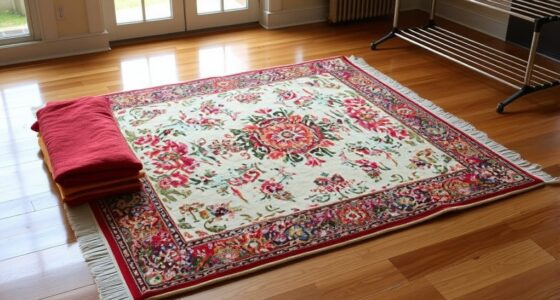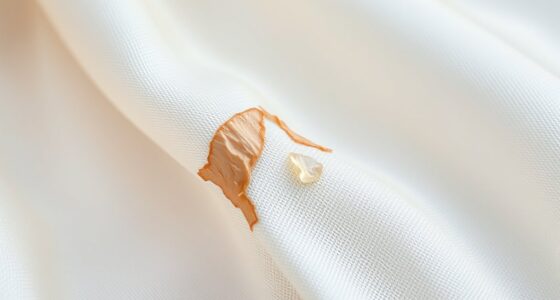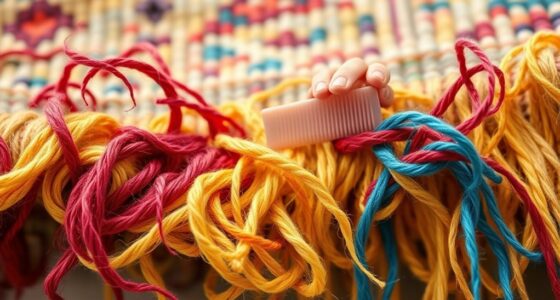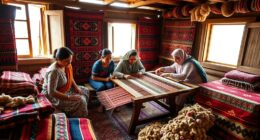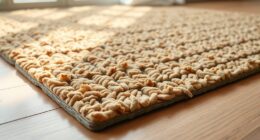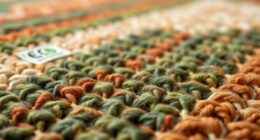If you’re deciding between conserving or restoring a rug, it’s important to understand the goals. Conservation focuses on preserving original materials, dyes, and features, maintaining the piece’s authenticity and historical value. Restoration involves repairing or reconstructing damaged areas, which can risk losing some original details. Proper techniques and professional guidance are vital to protect your rug’s genuine character and value. Keep exploring to discover which approach best suits your collection’s long-term importance.
Key Takeaways
- Conservation focuses on preserving original materials and appearance, while restoration involves repairing or replacing damaged parts.
- Ethical standards prioritize maintaining the rug’s historical integrity and authenticity during both conservation and restoration.
- Proper technique selection depends on the rug’s condition, with conservation preferred for stable fibers and original features.
- Both approaches carry risks; professional assessment and expertise are essential to avoid damaging the rug’s value.
- Preserving original dye, knot density, and features enhances the rug’s cultural significance and market worth.
Defining the Goals of Preservation and Repair
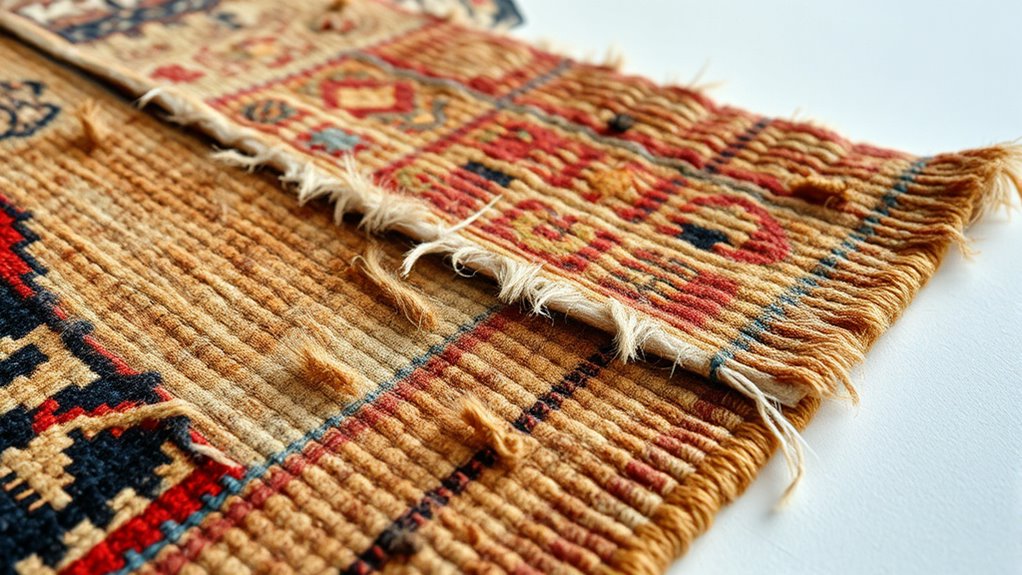
Understanding the goals of preservation and repair is vital because they guide how you approach caring for a rug. You want to respect its cultural significance, which often reflects the history and craftsmanship of its origin. Preservation aims to maintain the rug’s original materials and appearance, honoring its authentic value. Ethical considerations also play a key role; you need to guarantee that any repairs or interventions don’t compromise its integrity or historical importance. Your goal is to balance protecting the rug’s aesthetic and cultural essence while preventing further damage. Additionally, considering water-related factors can be crucial, especially since exposure to water can lead to deterioration or mold if not properly managed. Proper conservation techniques are essential to ensure that any intervention aligns with these goals and preserves the rug’s historical integrity. Implementing specialized methods tailored to the rug’s specific materials helps ensure that conservation is both effective and respectful of its age. Recognizing the importance of material analysis can guide appropriate intervention strategies. Employing environmental controls such as humidity and temperature regulation further supports long-term preservation. By clearly defining these objectives, you help guarantee that your conservation efforts are respectful, responsible, and aligned with the rug’s true worth.
Techniques Used in Rug Conservation
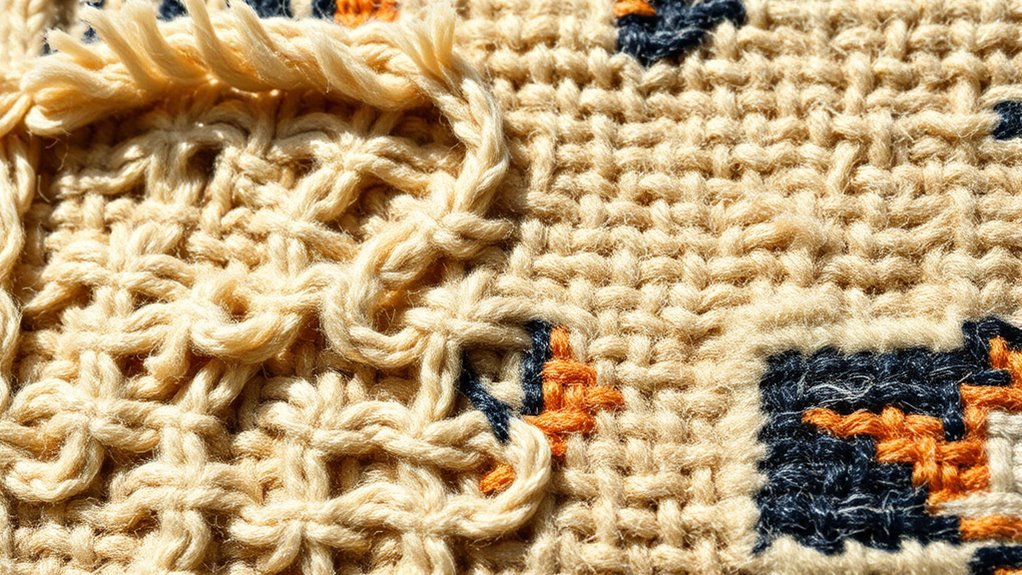
Rug conservation employs a variety of specialized techniques designed to stabilize, repair, and preserve textiles while respecting their original integrity. One key method involves guaranteeing dye stability, which prevents colors from fading or bleeding over time, preserving the rug’s authentic appearance. Knot repair is another essential technique, where damaged or missing knots are carefully replaced using similar materials to maintain the rug’s original craftsmanship. Conservators also use gentle cleaning and chemical treatments to remove dirt and stains without harming fibers or dyes. These methods are performed with precision to avoid altering the rug’s character or value. Additionally, understanding current conservation techniques and their application to fiber preservation can improve the preservation process and ensure the longevity of valuable textiles. Proper material analysis helps identify the specific fibers and dyes used, guiding appropriate conservation strategies. Employing ethical standards in conservation ensures that interventions do not compromise the textile’s historical significance or authenticity.
Common Methods Employed in Rug Restoration
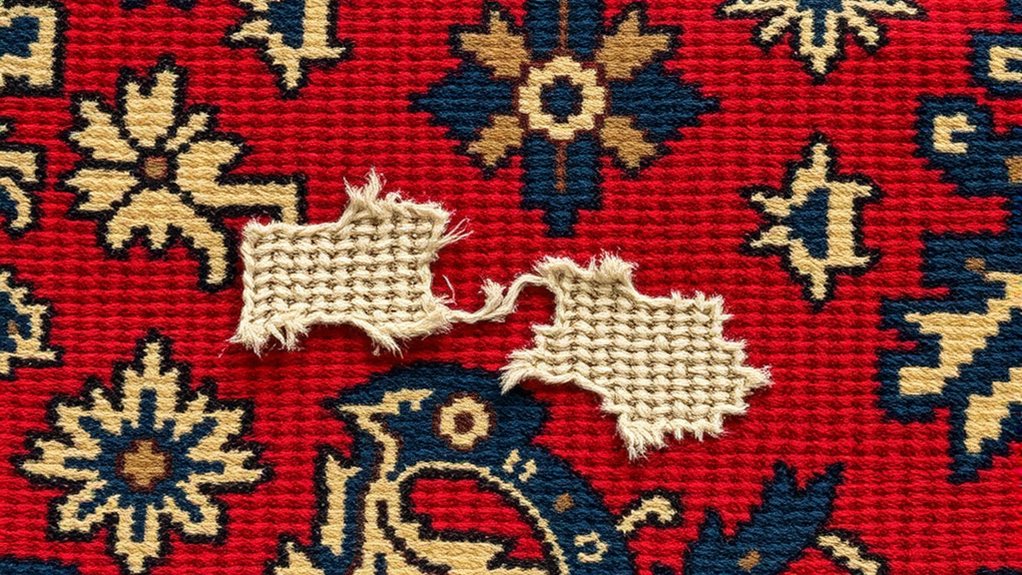
When restoring a rug, conservators employ a range of effective methods to repair damage and bring back its original appearance. One key technique involves ensuring dye stability, so colors remain vibrant and do not fade over time. They carefully test and stabilize dyes before applying any treatments. Fringes repair is another common method, where frayed or missing fringes are reconstructed using new fibers that match the original in texture and color. Conservators may also reweave or reinforce worn areas, fill holes with matching yarns, and clean the rug thoroughly to remove dirt without damaging delicate fibers. These approaches aim to preserve the rug’s integrity while restoring its beauty, balancing the need for preservation with minimal intervention. Additionally, glycolic acid treatments can be used cautiously to facilitate gentle cleaning and exfoliation of surface grime, helping to restore the rug’s original luster without compromising the fibers. Proper preservation methods also consider the importance of dye stability, ensuring that the colors remain protected against fading over time. Understanding the fiber types used in the rug can help conservators select the most appropriate cleaning and restoration techniques, ultimately extending the lifespan of the piece. Moreover, employing testing procedures allows for a tailored approach that minimizes risks to the rug during restoration.
Impact on Historical and Monetary Value
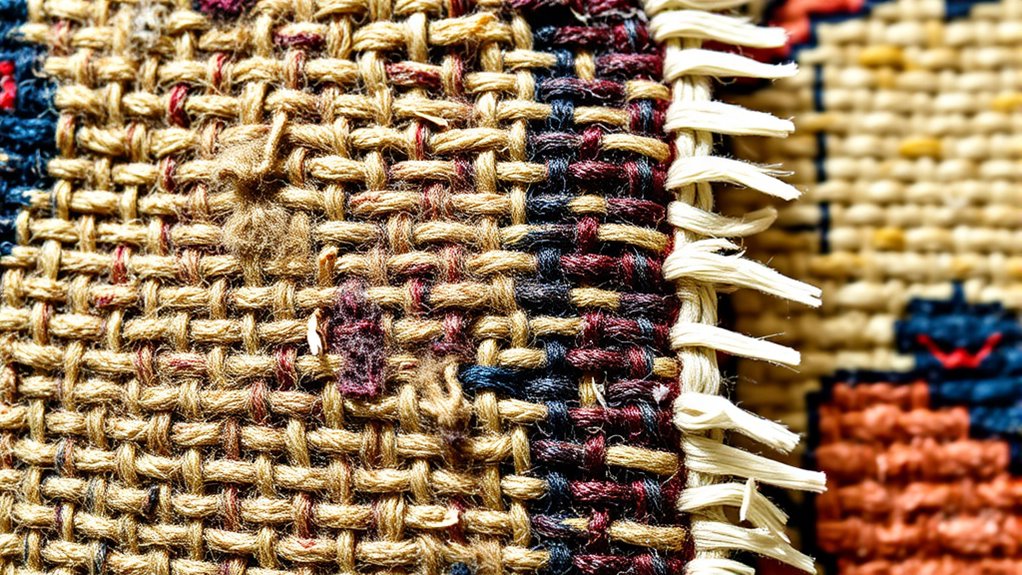
Your choices in conserving or restoring a rug considerably affect its authenticity and historical integrity. These decisions also influence the rug’s appraisal value, either preserving or diminishing its monetary worth. Understanding how each approach impacts both the rug’s history and its market value is essential for making informed decisions. Additionally, being aware of ethical considerations in restoration can help ensure that preservation efforts respect the rug’s original craftsmanship and cultural significance. Incorporating proper documentation during restoration processes further supports transparency and authenticity in preserving the rug’s provenance. Recognizing the importance of educational resources about rug history and techniques can guide collectors in making more informed preservation choices. Considering the rug’s value as a collectible can guide whether to prioritize preservation or restoration based on its significance and potential market impact. Moreover, understanding the vibrational energy associated with the rug can influence how it is maintained and appreciated, potentially enhancing its historical and monetary value.
Preservation of Authenticity
Preserving the authenticity of a rug directly influences its historical significance and monetary value. Maintaining original dye stability guarantees the colors remain true to the rug’s period and craftsmanship, preserving its cultural integrity. High knot density reflects the skill and effort invested by the weaver, which contributes to the rug’s uniqueness and worth. When conservation efforts focus on retaining these elements, you protect the rug’s provenance and authenticity. Altering dyes or reducing knot density can diminish its original character, lowering its value. Collectors value rugs that stay true to their initial creation because they tell a genuine story of origin and artistry. By prioritizing authenticity, you ensure the rug’s importance, both historically and financially, remains intact for future appreciation.
Effect on Appraisal Value
Maintaining the authenticity of a rug considerably influences its appraisal value, impacting both its historical importance and market worth. When a rug retains its original qualities, appraisers see it as more valuable, reflecting its true age, craftsmanship, and provenance. Conservation that preserves these elements typically results in a positive appraisal impact, enhancing the rug’s market value. Conversely, restoration that alters or obscures original features can diminish its desirability and reduce its worth in the marketplace. Collectors and appraisers prioritize authenticity, so any intervention that maintains the rug’s integrity tends to support higher appraised values. Ultimately, preserving the original condition and details ensures your rug’s monetary worth aligns with its true historical significance, making it a more valuable asset over time.
Historical Integrity Maintenance
When a rug’s historical integrity is upheld, its true cultural and artistic significance remains intact, directly influencing both its historical importance and monetary value. Preserving features like original color and fringe details is key. Color fading can diminish authenticity, lowering value, while proper fringed repair maintains structural integrity without compromising originality. To help you assess, here’s a simple overview:
| Aspect | Impact on Value | Preservation Tip |
|---|---|---|
| Color Fading | Reduces authenticity, decreases value | Use gentle cleaning, avoid UV |
| Fringed Repair | Should be minimal, preserve original look | Opt for seamless, discreet fixes |
| Overall Integrity | Maintains historical significance, boosts worth | Prioritize conservation over restoration |
Maintaining these elements ensures your rug preserves its historical and monetary worth.
When to Opt for Conservation Over Restoration

You should choose conservation when maintaining the rug’s original details is a priority. It helps minimize further damage and preserves the piece’s authentic character. In these cases, conservation guarantees the rug’s history remains intact for future generations.
Preservation of Original Details
Deciding to conserve a rug’s original details often hinges on recognizing their historical and aesthetic significance. If the colors have faded but still reveal the original dye techniques, preservation helps maintain authenticity. You should prioritize conservation when the material remains stable, meaning the fibers are strong and not deteriorating. Restoring the rug’s appearance by replacing or overdying colors could erase its unique history. By conserving, you preserve the rug’s character and craftsmanship, ensuring that its age and original details stay intact. Avoid unnecessary interventions that could compromise the fabric’s integrity or erase subtle nuances. When the primary goal is to retain the rug’s authentic look and feel, conservation is the best approach, especially if the materials are stable and the faded colors tell a story worth preserving.
Minimizing Further Damage
To prevent further damage, conservation is essential when a rug shows signs of deterioration that could worsen with improper restoration efforts. If the fibers are fraying, colors fading, or structural integrity compromised, you should prioritize conservation techniques that stabilize the rug without altering its original appearance. This approach helps preserve its framing aesthetics and maintains its cultural significance. Restoration, which can involve replacing or reweaving damaged sections, risks erasing historical details and diminishing authenticity. By opting for conservation first, you minimize the chance of irreversible harm. Remember, the goal is to stabilize and protect the rug while respecting its original craftsmanship and cultural context. When in doubt, consult a professional to determine whether conservation or restoration best suits your piece’s needs.
Risks and Considerations in Each Approach
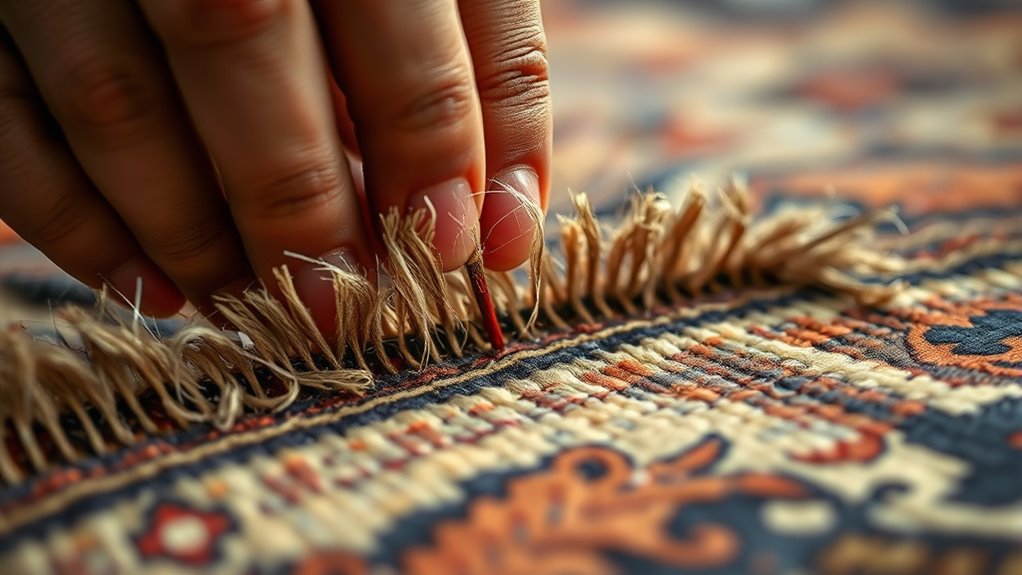
Both rug conservation and restoration carry inherent risks that must be carefully weighed before proceeding. Environmental factors, like humidity and light, can worsen damage if not managed properly, regardless of the approach. Additionally, altering a rug’s physical or visual state might compromise its cultural significance, especially if changes are irreversible.
Both conservation and restoration carry risks that can impact a rug’s integrity and cultural value.
Consider these risks:
- Conservation efforts may inadvertently weaken fibers if not done correctly
- Restoration can obscure original craftsmanship, affecting authenticity
- Over-restoration risks removing historical evidence
- Environmental conditions during treatment can cause further deterioration
Understanding these risks helps you make informed decisions that balance preserving a rug’s integrity with respecting its cultural importance. Always evaluate the potential impact of each approach to safeguard your collection’s value and meaning.
How to Choose the Right Professional for Your Rug
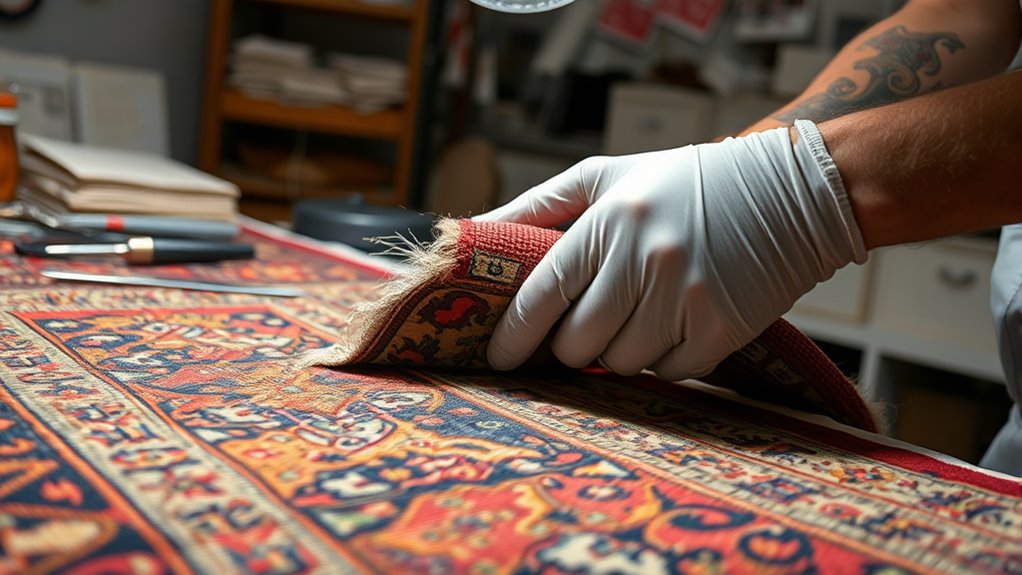
Choosing the right professional for your rug guarantees that your conservation or restoration project is handled with expertise and care. Look for specialists experienced in fiber dyeing, ensuring they can match original colors accurately. Check their knowledge of knot density, as this affects the rug’s overall integrity and authenticity. A qualified professional will assess your rug’s condition thoroughly, explaining whether restoration or conservation is best. Ask about their background, certifications, and portfolio of past projects. Avoid amateurs; proper fiber dyeing techniques and attention to knot density are vital for preserving your rug’s value. Trust professionals who prioritize preservation over unnecessary restoration, respecting the rug’s original craftsmanship and materials. Making an informed choice ensures your rug remains a treasured piece for generations.
Frequently Asked Questions
How Do Conservation and Restoration Affect a Rug’S Authenticity?
When you consider how conservation and restoration affect a rug’s authenticity, you realize that these processes aim to preserve its original qualities while maintaining its aesthetic impact. Proper conservation supports authenticity preservation by stabilizing fibers without altering design or materials. Restoration, if done carefully, enhances appearance but could risk compromising authenticity if overdone. Ultimately, balancing these efforts guarantees your rug retains its genuine value and visual charm.
What Are the Long-Term Costs of Conservation Versus Restoration?
Imagine choosing between maintaining your rug or restoring it—each choice impacts your wallet differently. Conservation often has lower maintenance costs over time, helping you avoid costly repairs. Restoring, while initially expensive, might lead to higher insurance implications due to its perceived value increase. Long-term, conservation tends to be more budget-friendly, whereas restoration could incur ongoing expenses and increased premiums, making it essential to weigh these costs carefully before making your decision.
Can Conservation or Restoration Be Reversed if Needed?
You might wonder if conservation or restoration can be reversed if needed. Generally, conservation processes are designed to be reversible, aligning with ethical considerations to preserve the piece’s integrity. Restoration, however, often involves irreversible changes, so it’s vital to take into account future needs beforehand. Always consult a professional to understand the reversibility of specific treatments and guarantee your rug’s long-term value and authenticity remain protected.
How Do I Determine if My Rug Needs Conservation or Restoration?
Your rug’s condition could be an emergency waiting to happen! To determine if it needs conservation or restoration, you should assess damage carefully. Look for signs like fading, fraying, or stains. Determine condition by examining fiber strength, color vibrancy, and any structural issues. If damage seems extensive or affects value, consult a professional. Proper assessment helps you decide whether gentle conservation or exhaustive restoration is needed to preserve your prized piece.
Are There Specific Materials or Techniques That Are Safer for Delicate Rugs?
When working with delicate rugs, you should prioritize using natural fibers and gentle cleaning techniques. Opt for materials like wool or silk, which are less likely to damage the rug. Always check dye stability beforehand; unstable dyes can bleed or fade with improper treatment. Using soft brushes and pH-neutral cleaners helps protect the fibers and preserves the rug’s integrity, ensuring it remains beautiful and undamaged over time.
Conclusion
Understanding the difference between conservation and restoration helps you make informed choices for your rug’s future. Did you know that over 70% of antique rugs can lose up to 50% of their value if improperly restored? By choosing the right approach and professional, you protect both your rug’s beauty and worth. Remember, preserving the original craftsmanship often retains more historical significance—and your investment. Make smart decisions to keep your rug’s story alive for generations.



